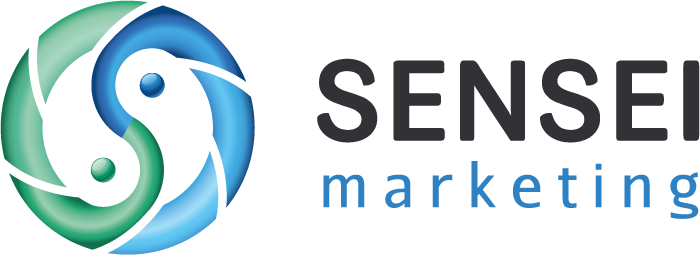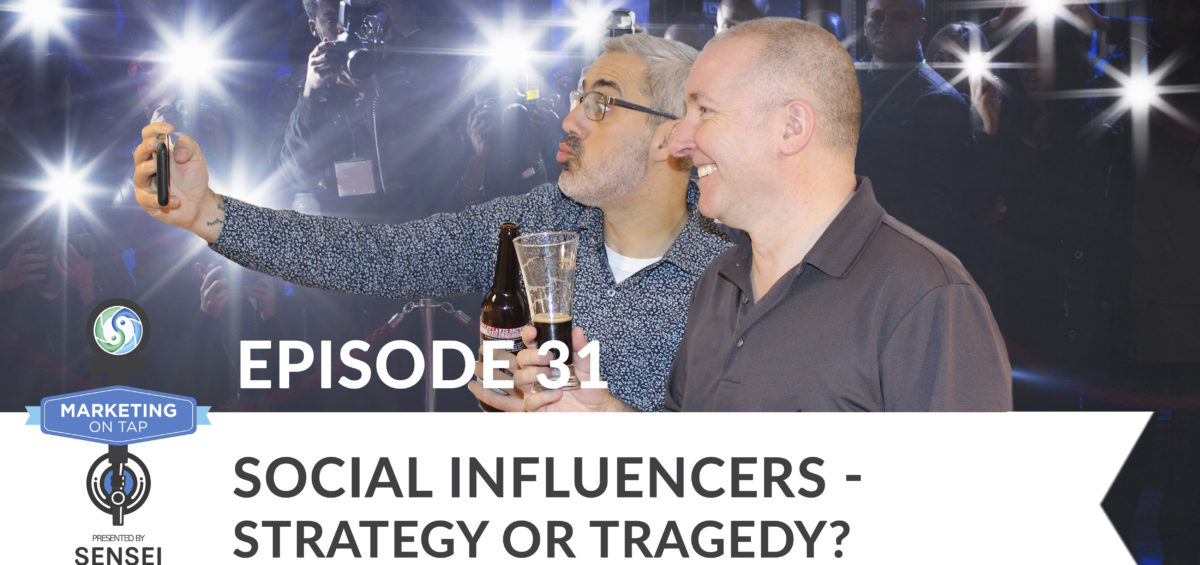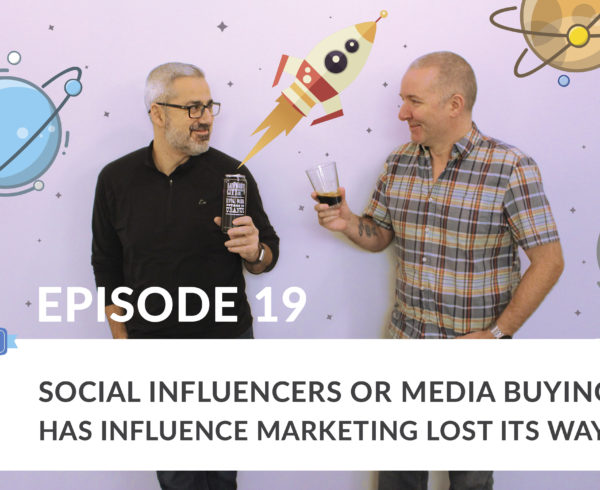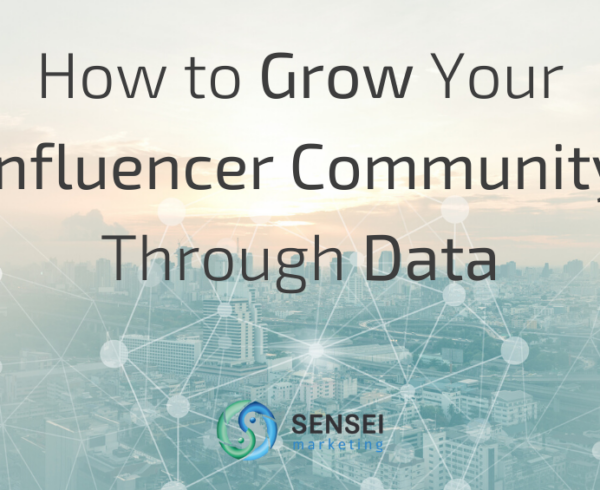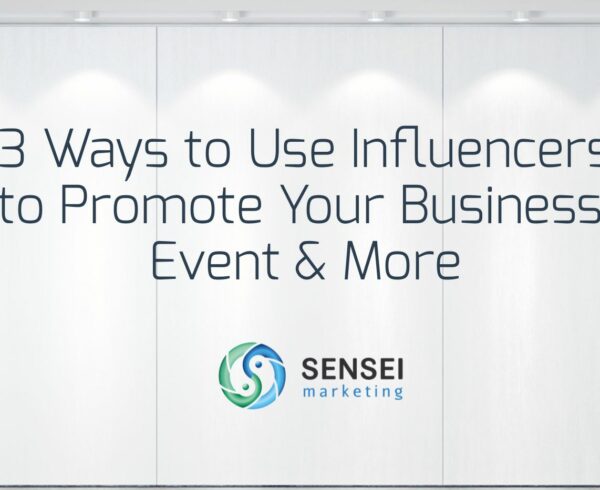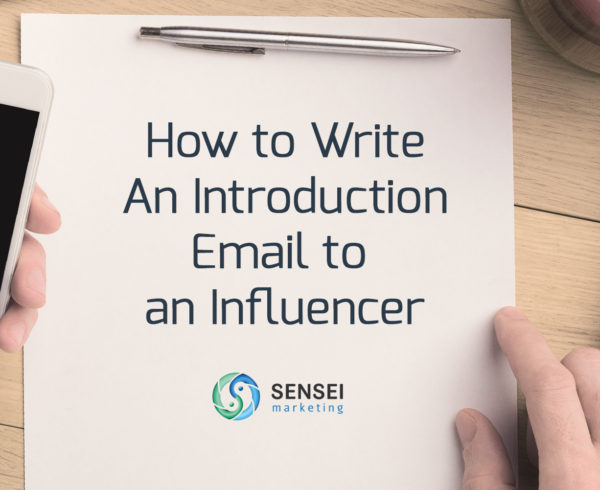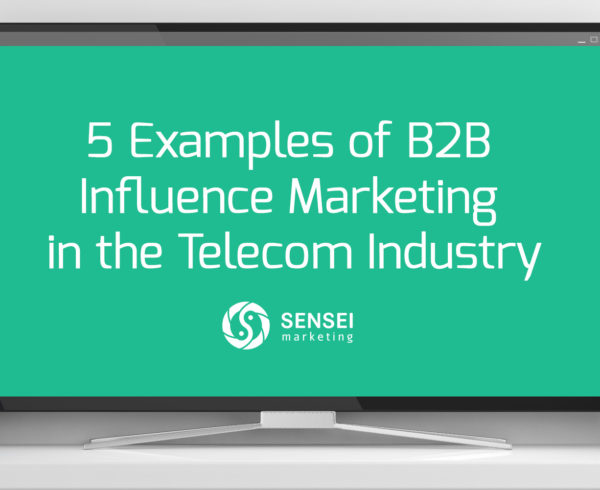Social influencers, and influencer marketing in general, are once again under the microscope as media publications share articles that are split into two trains of thought.
The first is that social influence is the worst thing to happen to marketing, while the second states that influence marketing is a key business strategy in 2019.
So which viewpoint is correct? Is there still a place for social influencers after the debacle that was Fyre Fest, or was that just an example of a poorly-executed program, and not reflective of a true influence marketing strategy and campaign?
In this week’s episode of Marketing on Tap, we look at the different opinions around influence marketing, and some of the things your business needs to be aware of with social influencers when it comes to your own marketing strategy.
Settle back and enjoy this week’s topic, brought to you in the usual unscripted manner that you’ve come to expect when Sam and Danny take the mic.
If you prefer to listen on the go, the audio version of this week’s episode can be listened to below.
Prefer podcasts? Subscribe below:
– Apple Podcasts: https://goo.gl/F7Tcfq
– Google Podcasts: https://goo.gl/kV3zpY
– Spotify: https://goo.gl/3osGCG
– Stitcher: https://goo.gl/gEXL6v
– Pocket Casts: https://pca.st/BuRy
– Radio Public: https://goo.gl/KdjQ6L
– Anchor: https://goo.gl/Fu1jZQ
– Breaker: https://goo.gl/9cgqqw
– CastBox: https://goo.gl/uawi1D
– Overcast: https://goo.gl/nrKmLo
This week’s beer is the Harry Porter and the Cherry Hoarder from Great Lakes Brewery.
***
Transcription:
Intro: Join marketers, authors, and craft beer enthusiasts, Sam Fiorella and Danny Brown for a hoppy discussion on all things digital over a cheeky pint or two. Topics on the menu include influence marketing, social media, brand advocacy and a taste testing of real world digital marketing campaigns. Some are smooth, others don’t sit so well. Don’t forget to stick around for last call where the boys will serve you up one final marketing takeaway that you can go out and apply in the real world. It’s a great primer before the weekend.
Sam Fiorella: Welcome back everybody to another episode of Marketing on Tap. As always, I am Sam Fiorella. This is my mate Danny Brown. Danny, today I want to circle back to influencer marketing.
Danny Brown: Okay, just for a change?
Sam Fiorella: Just for a change. I want to circle back to influencer marketing because there’s been a whole slew of articles written lately, I guess, post-[Fry 00:01:00] Festival fiasco, and now even with the news of the celebrity kids who have been bribed, basically into getting college admissions, because of what they’ve been posting online. The fake pictures of them, as well as what they were doing in their application letters. So there’s been this whole renewal of FTC requirements, which I think go back to 2017, that are requiring people to put disclaimers in their posts. And for most part, a lot of people are doing it, but they’re using things like #sp.
Danny Brown: Or #ad, or whatever.
Sam Fiorella: Yeah, for sponsored. And nobody understands that. The average user doesn’t understand that. So it’s starting, I guess, to backfire on them. And there was a recent article in the New York Times, or sorry, Los Angeles Times, that talked about, this is finally the end of influencer marketing. And then the very next day I got another article over on Daily Hive that talks about why influencer marketing is one of the most important strategies for 2019. So seven, eight years later, we’re still talking about influencer marketing and it’s, there’s still no consensus. Is this the best thing in the world or the worst tactic ever and it’s dead? And so I want to sort of circle back, see where we are today, what’s the state of the industry and what do the people out there listening want to know. So that’s today’s topic, but I’m excited to switch over to beer for a minute.
Danny Brown: Yep. This week it’s our friends over at Great Lakes Brewery in Etobicoke, Ontario. It’s about, what, 15 minutes away from us, in the car. Great Lakes is an awesome brewery, greatlakesbeer.com. They make some great beers, we’ve been at the tap room a few times, and really good cores and seasonals. Today’s is the Harry Porter & the Cherry Hoarder. Now, Harry Porter’s one of the Tank Ten series, so it’s a special brew that’s mixed seasonally, and they experiment with different flavours. So this one’s got cherries, delicious cherries, chocolate-
Sam Fiorella: Not just cherries.
Danny Brown: Not just cherries, delicious cherries. And there’s also chocolate, coffee, oh did I mention there’s cherries. So it should be pretty smooth. Maybe a little bit of acidity to it. It’s a 6.5 percent ABV and a 33 IBU. So IBU isn’t too bad, it shouldn’t be too bitter.
Sam Fiorella: I already love the colour of this.
Danny Brown: You smell the porter. [crosstalk 00:03:30].
Sam Fiorella: This is … I love Great Lakes and this one here is, unlike a lot of the beers we’ve been trying up until now, you’ve always been introducing something new. This one I actually really enjoy.
Danny Brown: So, cheers guys.
Sam Fiorella: So everybody cheers.
Danny Brown: Cheers. Cheers, [Robert 00:03:42].
Sam Fiorella: Robert, what do you think of this one? Hey, look at that.
Danny Brown: Thumbs up for Great Lakes. Not al fruity beer, but the cherries are really subtle in this, I think.
Sam Fiorella: No but, I think, again, Robert likes the thicker, creamier, like a Guinness like I do. And this one here, just with a little bit different flavor. It’s kind of got that texture.
Danny Brown: So check it out, greatlakesbeer.com. Great job.
Sam Fiorella: Harry Porter. Nice nice play on words there. So getting back to influence marketing. So, all right, I’m just going to ask flat out what are we supposed to believe? Is influencer marketing the best strategy for marketers in 2019 like these articles are referencing, or like the Los Angeles Times, the worst thing to happen to marketing? Like ever.
Danny Brown: Yeah, I think they’re both correct, in a way. Influence marketing-
Sam Fiorella: We have to take a position today.
Danny Brown: Yeah, I know, I’m Scottish, I don’t have a lot of opinions. Like I don’t … No, I mean, we spoke about this-
Sam Fiorella: Don’t let me pull up the story of the Jacobites. I’m sure you’ll have an opinion.
Danny Brown: Oh yeah, yeah. No, I mean, we spoke about this [inaudible 00:04:51] years ago. Influence marketing done right works. But it’s not the only strategy. And I think some of these reports are talking, when they say it’s the best strategy for digital marketers in 2019, that’s kind of hyperbole. Hyperbole. Hyperbole. Hyperbole. See, I can’t even pronounce the word properly. So now, if done properly, we know it works. We work with clients and we do influencer campaigns. We also see some people in that industry and how they maneuver numbers, metrics, et cetera. Which certainly talks back to, it is the worst thing when you start getting half lies like that to boost your opportunity to work with brands. So I think they both do have some semblance of truth to them.
Sam Fiorella: Yeah, and I think that as a media, our industry media in particular, is doing a really shit job of promoting or educating the audience. Because they’re looking for those headlines. Like one of the articles that I have up on my screen right now, “Why influencer marketing is one of the most important strategies for 2019”. And when you read the article, what the article is really doing, it’s an advertisement for an agency, and it’s not a native ad, I mean, this is not a paid advertisement, but they just needed something click bait, like why influencer marketing is one of the most important strategies. And you read the article and it talks about an agency that hired an influencer to head up their influencer marketing strategies.
Danny Brown: Right, isn’t she Business Director of Social Media, or Influence-
Sam Fiorella: I think that was her title, that she was being brought on. But she was an influencer, meaning that she had built up a large Instagram following and was being paid to post pictures of her either holding or using the product or whatever. And because of the, I guess notoriety that she built up around our Instagram channel, a marketing agency actually hired her to run their influencer marketing strategy. So my first thought on this was, that’s bullshit. I mean, what kind of an idiot agency would do something like this? Not hire somebody with tried and true marketing tactics and strategies. But then I thought, okay, hold on. That was my knee jerk reaction. So I want to talk to you about this a little bit and get your thoughts.
Sam Fiorella: Their philosophy was that an influencer who’s already built a strategy and executed a strategy successfully for how to engage brands on social media, they’ve got direct insight into those brands and what are brands looking for. So why not bring them in house and leverage that experience to building a whole department around that. Because she has this direct insight as to what brands are looking for. Is that something that most marketers should be doing instead of hiring a seasoned marketer like you and me, with some gray hair, or no hair as the case may be? Should they be looking for these 20 somethings that are flogging shoes on Instagram?
Danny Brown: In fairness to this particular influencer, I checked, I looked at LinkedIn, and it seems she does have some business background, like business strategy background. There’s no descriptions to the titles she has, so it’s just by titles. But to your point, I mean, it makes sense from … If you want to get into the insights of what works when it comes to connecting brands to the consumers. Do I want to go for it based on the influencer the consumers are following? It kind of makes sense to either work with them or consult with them or whatever.
Danny Brown: I’m not sure based on the business, like I said, not on her business background. I’m not sure if, based on the business background, that it makes sense. What’s interesting about this particular one though, and that piece I read, you sent it to me, and it mentions that her blog was one of the most popular in Canada by the Hive, which this piece is on. And Elle Magazine [inaudible 00:00:08:53]. At the bottom where she highlights who she shops at, that links to her various sponsors, there’s no disclaimer. So this agency is bringing on an influencer who doesn’t disclaim that she’s paid. She does it on Instagram, but not on her website. And that’s key. So is that the best person to bring on to advise you? Well yeah, I can connect you with the influencers, but I’ll not maybe mention I’m actually getting paid as an influencer. So that kind of stuck out for me there. And that’s a danger, I think.
Sam Fiorella: That is a danger. And it raises two points in my mind. Number one, are marketers, marketing agencies, or anybody, qualified and trained to hire people like this. Maybe it’s just because, again, we’re old and we’ve been doing this for so long, one of the first things we’d look at is their actual work. I’m a hiring this person because they’ve proven themselves as a social media influencer to drive awareness and brand engagement. Are they following the letter of the law? Are they following best practices? Let me check that. Clearly they didn’t. Or maybe they did and they-
Danny Brown: Don’t care.
Sam Fiorella: And we haven’t spoken to this agency, so I don’t know. But maybe they looked at it and didn’t care, or they think, well, maybe we’ll train them. So that, again, opens up the whole other issue for marketing agencies or Directors of Marketing, CMOs that are hiring these people. Get with it. Understand what is legal. Understand what best practices. Understand to cut through the BS that this market is generally built on. So that you know how to hire somebody and bring them in house. I keep going back to [Joel Ostrowski, The Fat Jew, as a-
Danny Brown: That’s a good example though.
Sam Fiorella: … that I think, a guy who built up a massive audience with some questionable content, but became famous, built up a huge audience, and then got paid, not only for his promotion of products, but now companies were hiring him to actually come up with campaign ideas. Because he proved that he was so good at developing content that engages, content that drives brand activation.
Sam Fiorella: So, I mean, clearly there are some of these guys. I love the idea of, when you find an influencer, instead of paying them for their audience to huck your product, which today is not as trustworthy as it’s ever been, and the statistics bear that out. If they’re good content producers and good campaign generators, hire them to develop your content. Hire them as content writers. which is, I think, what this agency was trying to do. So my initial reaction to that, that’s BS, I’m actually rethinking my strategy on that. Because if she is as good at developing the content, then why not?
Sam Fiorella: But the second point that came to my mind that I want to ask you about is, can you actually trust … You said, well, there’s not a lot of description around her job titles when you look her up on LinkedIn. She’s not using the proper disclaimers that the FTC, at least in the United States, requires. And I know here in Canada it’s the same thing. Australia, it’s actually law. Here’s it’s just a guideline. In the UK and Australia it’s actually law, and apparently that’s coming here now as well. So when you look at that, how much can you believe? When you take a look at the Fry Festival, as an example-
Danny Brown: The Fry Festival?
Sam Fiorella: Fyre Festival, not Fry Festival.
Danny Brown: Just all these french fry influencers that McDonald’s sent.
Speaker 4: [inaudible 00:12:12].
Sam Fiorella: Yeah, probably.
Danny Brown: I’m going to create that.
Sam Fiorella: I did just have lunch. We can create Fry Festival.
Danny Brown: Let’s create Fry Festival.
Sam Fiorella: If we can merge it with one of the beer festivals we go to-
Danny Brown: Beer and fries?
Sam Fiorella: Beer and fries.
Danny Brown: I like it.
Sam Fiorella: I like that. So anyway, with the the Fyre festival that got so much negative publicity because it did everything wrong. I mean, I don’t want to rehash that campaign. I think everybody knows what it is and what went wrong with it. But that, I guess, right now is what’s on everybody’s mind if you’re a brand looking to hire an agency or influencers, or if you are a consumer looking at these campaigns and people like the Kardashians that are promoting product. There’s just so much distrust in the marketplace right now that I don’t know how any traditional influencer marketing campaign can be seen as effective. Because there’s just no trust there.
Danny Brown: Yeah. Well I think, the keyword you mentioned there is traditional influence marketing. We always spoke about marketing, online marketing, we always pulled back to traditional marketing. The guts and bolts or whatever. Nuts and bolts.
Sam Fiorella: Nuts and bolts.
Danny Brown: Nuts and bolts. We’re all struggling today. Basically it’s just marketing though. But traditional influence marketing, where you do it properly, you’ve got a strategy you’re using multi- channels, not just influencers online, et cetera. We know that works because it’s done properly by the books and it’s clear that it’s either an ad, and advertorial, or whatever. Where, and especially with the FTC and ad standards in Canada stepped in, was because you had influencers on social who are just, there was no distinction that it was an ad and it was paid for versus just someone saying, “I love this top”, “I love these pants”, or whatever. So yeah, the lack of trust is in marketing anyway. Consumers don’t like marketers. So I think if you do something that’s almost … And visible that it is a marketing campaign, then-
Sam Fiorella: It’s funny because I just … This last two weeks we’ve been getting a lot of leads coming in and referrals. Most of them I have not even bothered bidding on work for ourselves because what they’re asking for are the wrong metrics. And when I speak to them I say, “Well this is really what you should be looking for and if we’re going to work with you this is how we would do it.” I can tell right away the, “No, no, no, no, no, I want to do this.” I want to do what they think works. So the lack of understanding of metrics is big. One of the … NeoReach did a study that there … a lot of influencer marketing agencies are promoting. And that is that for every dollar invested in influencer marketing campaigns, brands received an average return of $5.20. So for every dollar invested, they got $5.20 back. And I thought, okay, that’s one hell of an ROI. That’s fantastic. But if you read the details of the campaign or of the research, it says they received $5.20 in earned media. Not in sales-
Danny Brown: Or leads, even.
Sam Fiorella: Or leads, we don’t know, but in earned media. So, okay. That’s still, I guess, good. If you’re going to invest in a PR campaign, what does a PR agency report back to you? If they’re doing awareness campaigns, you’re launching a new brand or you’re launching a new product-
Danny Brown: Yeah, it’s AVEs, right?
Sam Fiorella: Exactly. So how many viewers are we getting? What’s the earned media, the equivalent earned media. For those of you that don’t know what earned media is, it’s basically, if I had to buy that ad in that newspaper or on that radio program or on that television program, what would that have cost them to advertise?
Danny Brown: So here it would have been the $5.26-
Sam Fiorella: Here it would have been $5.26 to get the equivalent exposure that a particular influencer would drive for you through social media channels. But I know one of the challenges that a lot of marketers have when they hire, let’s say a marketing agency, as opposed to hiring a PR agency to do the same work, is that for us, they hold us accountable to sales. Marketing qualified leads, convertible leads, and bottom line results. How much did you convert? Whereas, a lot of times, one of the reasons they do hire us instead of a PR agency is because a PR agency is often held accountable to earned media, which is fine. That’s what they’re trying to do. That’s their metric and that’s good.
Sam Fiorella: But I think, again, one of the … I want to warn everybody that is still looking to do this, and at least for those of you that are calling us, we don’t play that game. Yeah, I mean, I would love to be able to say, “Look at the earned media”. And in a couple of case studies we do report that, if you look at our website, we do report earned media. Because that’s what the client wanted, that’s what we did. But then we don’t … That was, one client, for example, we didn’t keep long term. We did the campaign, they were happy with that, and they didn’t hire us again to do the follow up or do anything else. Because the CFO eventually stood up and said, “Okay, well, what does that mean? Great, I got this earned media, but that earned media. How do I attribute that to my bottom line? How do I attribute that to my sales?” And I think this is where talks about hiring traditional influencers or using that traditional channel of paying somebody with a large social media following to promote your product is going to come back to bite you in the ass long term.
Sam Fiorella: So ask for the right metrics. How do we do it here? Like what’s the difference between what we do, for example, and what others do? Not that that I’m trying to promote our company, but just, we’re confident in what we do. I know what I’ve been saying to people. What would you say to somebody that comes to you and says, “Well, why is that wrong?” What would you do differently? What metric would you be … should you be asking for from a marketing agency or from a campaign?
Danny Brown: Based on a campaign?
Sam Fiorella: Yeah, well obviously.
Danny Brown: Obviously, no, based on a campaign. I was actually formulating a sentence, it wasn’t a question. But based on a campaign, I mean, I know we are looking to look for awareness. So, initial part, awareness. Okay, now we’ve got the awareness, what does that mean? How many visits are we driving to the website? How many downloads are driving of an e-book or a sign up? How many demos are we getting from a tech company, et cetera? Once we’ve got that, how many leads have we actually qualified? How many people are we getting to take ongoing tests, et cetera?
Sam Fiorella: But is that really fair? I’m going to play devil’s advocate for a minute.
Danny Brown: Okay, sure.
Sam Fiorella: Is that really fair? Is it fair to ask a company … like as a marketer our job, arguably, is brand awareness. Marketing is about-
Danny Brown: You can’t make a sale without awareness.
Sam Fiorella: Yeah, we’re not the sales team, we’re the marketing team. So if we can drive awareness, then that’s … and the earned media is five to one in terms of have an ROI, then why is that such a bad thing?
Danny Brown: Well awareness doesn’t … As I say, it goes back to marketing. Qualified leads. We could drive a million visitors to your website. Great. Then only 100 of them might be actually interested in that brand or product or service. And then the buy in, ready to buy at that time, and the customer lifecycle. The purchase lifecycle. And so awareness is great. You need awareness, but you have to keep going beyond that. And then once you’ve got the lead, many of our clients, we work with them on multi-year contracts because we’re growing a program from start to finish, and turning awareness into sales, or lead sales advocacy, return.
Sam Fiorella: So it comes into multi-phase. I know for us we say, “Sure, step one is to build the awareness.” And then from that awareness, how do we leverage that awareness? How do we build in the various calls to action embedded into the messaging or the tactic that drives measurable or trackable leads back? So sometimes that’s a multi-phase, multi-year approach. A lot of clients don’t give us or other marketers the opportunity to do that because they’re looking for results today. They’re looking for results tomorrow. This is where I butt heads with a lot of marketers out there. Because we actually turned away clients that, that’s all they want. We’ll say no. You know what I mean? Robert and I are talking about this all the time, because he’s even more brutal about not taking on a client than I am. And it’s like, well, it’s just not going to be a big enough a client. Because they’re not long term visioned enough. They don’t see phase two, phase three.
Sam Fiorella: And you know what, and he’s right. Because a lot of times when we have taken on these one term, only one phase projects, where earned media or awareness or followers and clicks are the metric, we never get the rest of that campaign. It always ends there because they always come back to us and say, “Well how does that affect my bottom line?” Even though we warn them at the beginning that this was the case. And I think a lot of marketers are just trying to take whatever business that they can get their hands on instead of saying to a client, “Look, if you’re not going to do it right, don’t bother doing it.” Go spend the money somewhere else. Maybe focus it on the sales. Do an event, go to a trade show, go more … back to that list. So we’re getting the signal, we’ve remembered our bell today.
Sam Fiorella: So that’s our last call. So Danny, last call, I’m going to pass it on to you. What’s the one takeaway from today’s recap or check in on influencer marketing that we want to leave everybody with?
Danny Brown: I think for me, for these examples, due diligence. People are crapping on influence marketing for bad results or stuff like Fyre Fest. But that’s because there was no due diligence. It seemed like a great idea and too good to be true. And if it seems too good to be true, it probably is. So check who you’re working with, check what the numbers are, and make sure they can back that up.
Sam Fiorella: Yeah, I agree. And I’m going to take the other side of that and add to it, is that if you are a marketer running one of these campaigns, make sure that the influencers that you’re using, whether you’re hiring influencers or whether you’re identifying advocates within your existing customer base and leveraging their social proof and their testimonials, make sure that you are using the recommended FTC disclaimers and not just using abbreviations like #sp for sponsored post. Make sure that you’re following the rules, because you don’t want to be on the bad side of that. Not only the negative PR that could happen if somebody calls you out or something goes wrong, or be on the wrong side of the FTC when they come and give you the warning letters or potentially fines for misleading the public. So that’s becoming a key thing for the Federal Trade Commission right now. They’re really clamping down on this kind of stuff.
Sam Fiorella: So anyway, hopefully you’ve taken some ideas, some insights and lessons learned from that, if you’re a marketer or a brand or an influencer yourself. Until next time, guys, thank you very much for following and for listening, as the case may be.
Danny Brown: If you’re watching on YouTube, make sure you hit the little bell that’s up here for notifications of new posts. Subscribe down at the bottom. Wherever that button is going to appear. And obviously if you’re on podcast, we’d love a review. We got some nice reviews recently, so-
Sam Fiorella: Oh, fantastic, we appreciate that. Thank you everybody.
Danny Brown: Thanks guys.
Sam Fiorella: And by the way, you know that … How many, this is what our 30th, 31st episode?
Danny Brown: 31st episode.
Sam Fiorella: You know that the bell always, or the follow thing, is always in the same point, right?
Danny Brown: Yeah, I know. But I just think one of these times it might appear somewhere else. I just want to try to keep up to date.
Sam Fiorella: All right guys. Cheers.
Danny Brown: Cheers everybody. Cheers.
Sam Fiorella: Cheers, Robert.
Outro: You’ve been listening to Marketing on Tap with Sam Fiorella and Danny Brown. If you enjoyed this episode, make sure to subscribe so you don’t miss the next one. And please feel free to leave a show review. That’s always worth a cheers.
